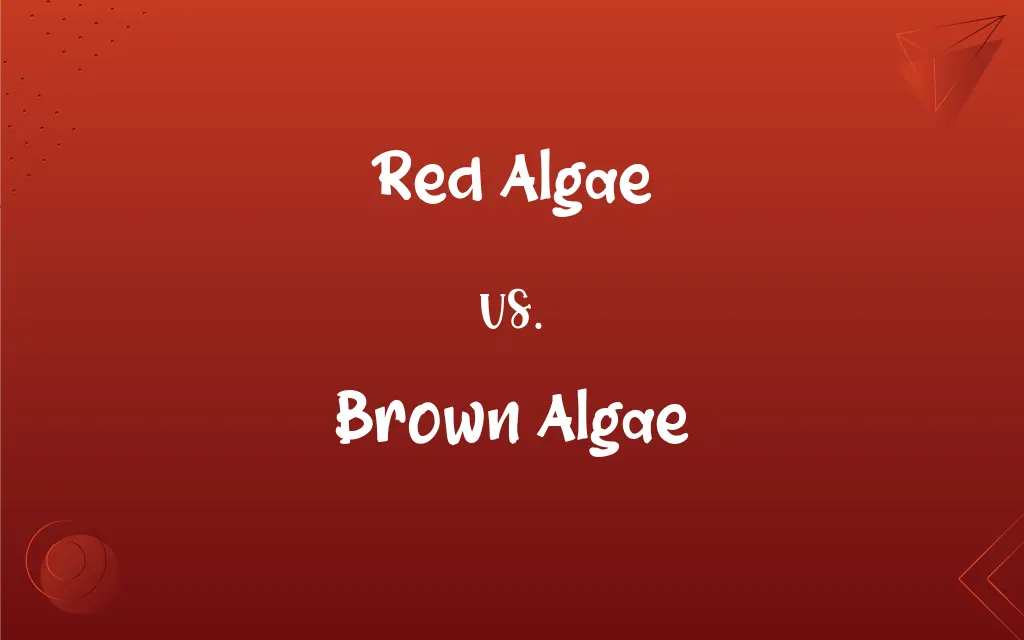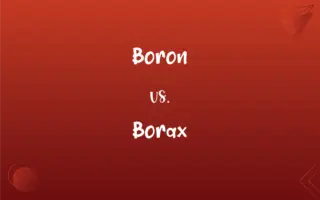Red Algae vs. Brown Algae: What's the Difference?
Edited by Aimie Carlson || By Janet White || Published on January 14, 2024
Red Algae is primarily marine, often found in deeper waters. Brown Algae mostly found in shallower, coastal waters.

Key Differences
Red algae, known scientifically as Rhodophyta, are predominantly marine and thrive in deeper, sometimes tropical waters. Brown algae, belonging to the Phaeophyceae class, are more commonly found in shallow, coastal environments, often in cooler regions.
The pigmentation of red algae comes from phycoerythrin, giving them their distinctive color and allowing them to photosynthesize in deeper waters. In contrast, brown algae possess a pigment called fucoxanthin, which gives them their brownish color and is effective in absorbing light in shallower waters.
Red algae are known for their contribution to coral reef formation and have a complex life cycle. Brown algae, on the other hand, are notable for their size, with some species like kelp forming extensive underwater forests.
In terms of usage, red algae are utilized in various industries for agar and carrageenan production. Brown algae find their application in the form of alginate, used in food and cosmetics.
Ecologically, red algae play a crucial role in marine ecosystems, providing habitat and food for marine life. Brown algae, particularly kelp forests, are vital for coastal ecosystem health, offering shelter and nutrients to a diverse range of marine species.
ADVERTISEMENT
Comparison Chart
Habitat
Deeper marine waters
Shallow, coastal waters
Pigmentation
Phycoerythrin
Fucoxanthin
Ecological Role
Coral reef formation
Kelp forest ecosystems
Industrial Use
Agar and carrageenan
Alginate
Distribution
Predominantly in tropical regions
Mostly in cooler, temperate seas
ADVERTISEMENT
Red Algae and Brown Algae Definitions
Red Algae
A group of mostly marine algae with a distinctive red color.
The red algae growing on the coral reef added vibrant colors to the underwater landscape.
Brown Algae
Vital for coastal ecosystem health and biodiversity.
Marine biologists stress the importance of brown algae in maintaining coastal biodiversity.
Red Algae
Characterized by their deep-water habitat and red pigmentation.
Divers marveled at the red algae thriving in the deep, clear waters.
Brown Algae
Used commercially for alginate production.
Brown algae are harvested for their alginate, a thickening agent in food.
Red Algae
Play an essential role in marine food chains and ecosystems.
The presence of red algae indicates a healthy and balanced marine environment.
Brown Algae
Known for large species like kelp, forming underwater forests.
The brown algae, especially the kelp forests, provide habitat for numerous marine species.
Red Algae
Used in various industries for producing agar and carrageenan.
The red algae extracted from the ocean is processed into agar for culinary use.
Brown Algae
Contains the pigment fucoxanthin, giving them a brownish color.
The brown algae's unique coloration is due to its fucoxanthin content.
Red Algae
Known for their contribution to the formation of coral reefs.
Scientists studied how red algae help in sustaining the coral reef ecosystem.
Brown Algae
A diverse group of algae, typically found in shallow, coastal waters.
The rocky shores were covered with various types of brown algae.
FAQs
Where is red algae commonly found?
Red algae are typically found in deeper, often tropical marine waters.
Where do brown algae thrive?
Brown algae mostly thrive in shallow, coastal waters, especially in cooler regions.
How do red algae contribute to the environment?
Red algae contribute to coral reef formation and serve as a vital part of marine ecosystems.
What is brown algae?
Brown algae are a diverse group of mostly coastal algae, often large like kelp, with a brownish color due to fucoxanthin.
What pigment is present in red algae?
Red algae contain phycoerythrin, which contributes to their red color.
What are some industrial uses of red algae?
Red algae are used in industries for producing agar and carrageenan.
What are the industrial applications of brown algae?
Brown algae are used for alginate production, a thickening agent in food and cosmetics.
What is the size range of brown algae?
Brown algae vary in size, from small species to large kelp that forms underwater forests.
Can brown algae be eaten?
Certain species of brown algae are edible, often used in culinary dishes.
What is red algae?
Red algae are primarily marine algae known for their distinctive red color and deep-water habitat.
What pigment is found in brown algae?
Brown algae contain fucoxanthin, giving them their characteristic brown color.
Are red algae edible?
Yes, some species of red algae are edible and used in various cuisines.
What is the ecological role of brown algae?
Brown algae, like kelp forests, play a crucial role in coastal ecosystem health and biodiversity.
Are brown algae affected by climate change?
Yes, brown algae, like kelp forests, are impacted by climate change, affecting their growth and distribution.
Is red algae found in freshwater?
While predominantly marine, some species of red algae can be found in freshwater environments.
Do brown algae only grow in saltwater?
Brown algae primarily grow in saltwater, especially in coastal regions.
Are red algae important for marine wildlife?
Yes, red algae provide habitat and food for various marine organisms.
Can red algae be used in medicine?
Some red algae have potential medicinal properties and are being researched for various applications.
Do red algae have a complex life cycle?
Yes, red algae typically have a complex life cycle involving different stages.
How do brown algae benefit marine animals?
Brown algae, particularly kelp forests, offer shelter and nutrients to a wide range of marine life.
About Author
Written by
Janet WhiteJanet White has been an esteemed writer and blogger for Difference Wiki. Holding a Master's degree in Science and Medical Journalism from the prestigious Boston University, she has consistently demonstrated her expertise and passion for her field. When she's not immersed in her work, Janet relishes her time exercising, delving into a good book, and cherishing moments with friends and family.
Edited by
Aimie CarlsonAimie Carlson, holding a master's degree in English literature, is a fervent English language enthusiast. She lends her writing talents to Difference Wiki, a prominent website that specializes in comparisons, offering readers insightful analyses that both captivate and inform.






































































